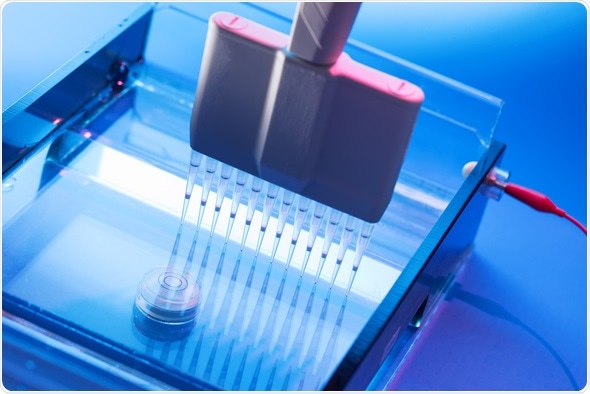Gel electrophoresis is a widely used technique in life science laboratories to separate macromolecules such as DNA, RNA, and proteins. In this technique, molecules are separated based on their size and electric charge. Gel electrophoresis is usually performed in labs to analyze DNA, RNA, or protein samples from various sources.

Loading DNA Samples onto an Agarose Gel for Electrophoresis - Image Copyright: science photo, Image ID: 214331152 via Shutterstock.com
Principles of gel electrophoresis
The gel electrophoresis technique exploits the difference in size and charge of different molecules in a sample. The DNA or protein sample to be separated is loaded on to a porous gel placed in an ionic buffer medium. On application of electric charge, each molecule having different size and charge will move through the gel at different speeds.
The porous gel used in this technique acts as a molecular sieve that separates bigger molecules from the smaller ones. Smaller molecules move faster across the gel while the bulkier ones are left behind. The mobility of the particles is also controlled by their individual electric charge. Two oppositely charged electrodes that are part of the system pull molecules of towards them on the basis of their charge.
DNA gel electrophoresis lab demo
How does it work?
The gel used in gel electrophoresis is usually made of a material called agarose, which is a gelatinous substance extracted from seaweed. This porous gel could be used to separate macromolecules of many different sizes. The gel is submerged in a salt buffer solution in an electrophoresis chamber. Tris-borate-EDTA (TBE) is commonly used as the buffer. Its main function is to control the pH of the system. The chamber has two electrodes – one positive and another negative - at its two ends.
Samples that need to be analyzed are then loaded into tiny wells in the gel with the help of a pipette. Once loading is complete, an electrical current of 50–150 V is applied. Now, charged molecules present in the sample start migrating through the gel towards the electrodes. Negatively charged molecules move towards the positive electrode and positively charged molecules migrate towards the negative electrode.
The speed at which each molecule travels through the gel is called its electrophoretic mobility and is determined mainly by its net charge and size. Strongly charged molecules move faster than weakly charged ones. Smaller molecules run faster leaving behind the larger ones. Thus, strong charge and small size increases a molecule’s electrophoretic mobility, while weak charge and large size decreases the mobility of a molecule. When all molecules in a sample are of the same size, the separation will solely be based on their size.
Once the separation is complete, the gel is stained with a dye to reveal the separation bands. Ethidium bromide is a fluorescent dye commonly used in gel electrophoresis. The gel is soaked in a diluted ethidium bromide solution and then placed on a UV transilluminator to visualize the separation bands.
The bands are immediately examined or photographed for future reference, as they will diffuse into the gel over time. The dye can also be loaded into the gel well in advance to track the migration of the molecules as it happens.
Applications of gel electrophoresis
Gel electrophoresis is widely used in the molecular biology and biochemistry labs in areas such as forensic science, conservational biology, and medicine.
Some key applications of the technique are listed below:
- In the separation of DNA fragments for DNA fingerprinting to investigate crime scenes
- To analyze results of polymerase chain reaction
- To analyze genes associated with a particular illness
- In DNA profiling for taxonomy studies to distinguish different species
- In paternity testing using DNA fingerprinting
- In the study of structure and function of proteins
- In the analysis of antibiotic resistance
- In blotting techniques for analysis of macromolecules
- In the study of evolutionary relationships by analyzing genetic similarity among populations or species
Molecular Biology
References
Further Reading